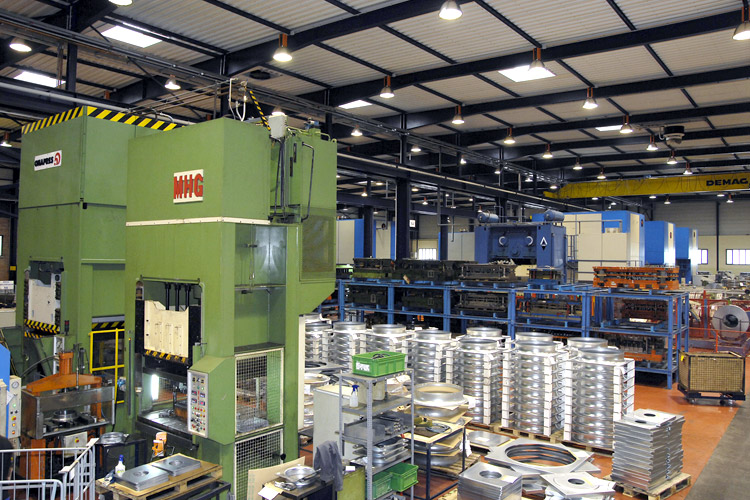Differences between cold metal stamping and hot metal stamping
There are two types of stampings, cold stamping and hot stamping, depending on the temperature applied to the material to be deformed.

Metal stamping or stamping is the manufacturing technique used for the transformation of metal sheet, where the piece is subjected to a compression load between two moulds. This load is applied through hydraulic or mechanical presses that provide a great capacity and versatility to apply the most efficient and productive processes depending on the requirements of each project.
There are two types of stampings, cold stamping and hot stamping, depending on the temperature applied to the material to be deformed.
DIFFERENCES BETWEEN HOT AND COLD STAMPING
The temperature applied in the deformation of the metal is the key factor that differentiates the technique of metal stamping in cold and hot. This line separating both processes is determined by the recrystallization temperature. If the temperature applied is higher than this, it is hot stamping, while if it is lower, the process is called cold stamping.
The recrystallization temperature is the temperature by which a cold-worked material is recrystallized, i.e., as with all deformed material, a microstructure is formed of new grains that have few dislocations in their crystalline structure. This factor depends on the melting temperature of the metal, as well as the degree of cold deformation, among others. Therefore, it is not a fixed temperature.
HOT METAL STAMPING
Hot stamping of metals is carried out at a temperature higher than the metal recrystallization temperature. This technique involves heating the material until it becomes malleable to form the required part.
Unlike cold metal stamping, the resulting part has less dimensional accuracy, although it allows more deformation of the part thanks to its high temperature.
COLD STAMPING
In cold metal stamping, the material is produced at a temperature lower than the recrystallization temperature. In this process, the deformation of the grain of the crystalline structure makes it possible to obtain anisotropy in the microscopic structure. Thus, properties such as the elasticity or ductility of the metal undergo alterations that make it possible to manufacture more resistant materials, as well as solutions for reducing the weight of the final piece.
At SOME, we are specialists in cold stamping processes. The main techniques we develop are:
- Deep and semi deep drawing
- Stamping with progressive dies
These metal stamping operations are aimed at projects that require high productivity in medium or long series.
For this purpose, at SOME we have a wide range of mechanical presses of up to 350 tons to develop the metal stamping process. We also have deep-drawing and semi-deep-drawing hydraulic presses of up to 500 tons.
This machinery allows us to carry out cold stamping operations to manufacture parts and components of different materials, such as steel, stainless steel or aluminium.
If you need more information on cold stamping techniques, please do not hesitate to contact our team.
Últimas noticias
-
SOME takes centre stage at the AI Congress 2025 in Barcelona
28/10/2025
The eleventh edition of the artificial intelligence congress brings professionals together in Barcelona and showcases success stories based on AI.
-
SOME travels to China to connect with the future of Industry 4.0 and AI
28/10/2025
The company takes part in a mission organised by ACCIÓ alongside 14 Catalan companies to learn firsthand about the most innovative practices in robotics and artificial intelligence.
-
Greater productivity and safety with the new DIMECO Stackmatic system
26/08/2025
SOME integrates the DIMECO Stackmatic die conveyor to achieve fast, safe, and efficient tool changes across our 15 presses.
-
SOME Industrial to attend industryLIVE 2025
20/05/2025
Get your free entry: register with code iLIVE25179 and visit us at Hall 8 – IFEMA Madrid
-
Success of the 3rd Edition of SOME’s International Paella Contest, an employee-led initiative supported by the company
18/05/2025
Creating spaces for connection beyond the production floor is key to strengthening internal cohesion and fostering a healthy work environment.